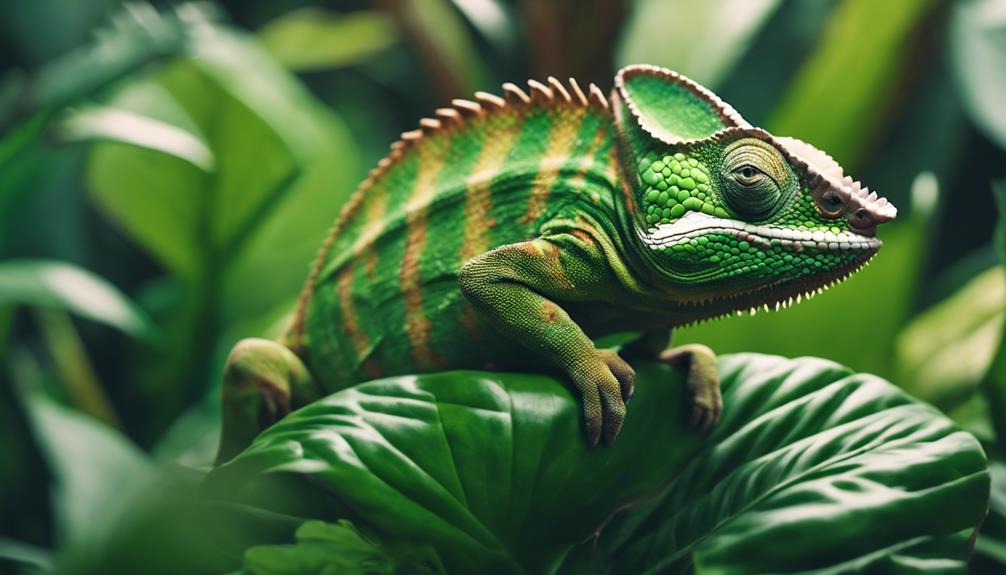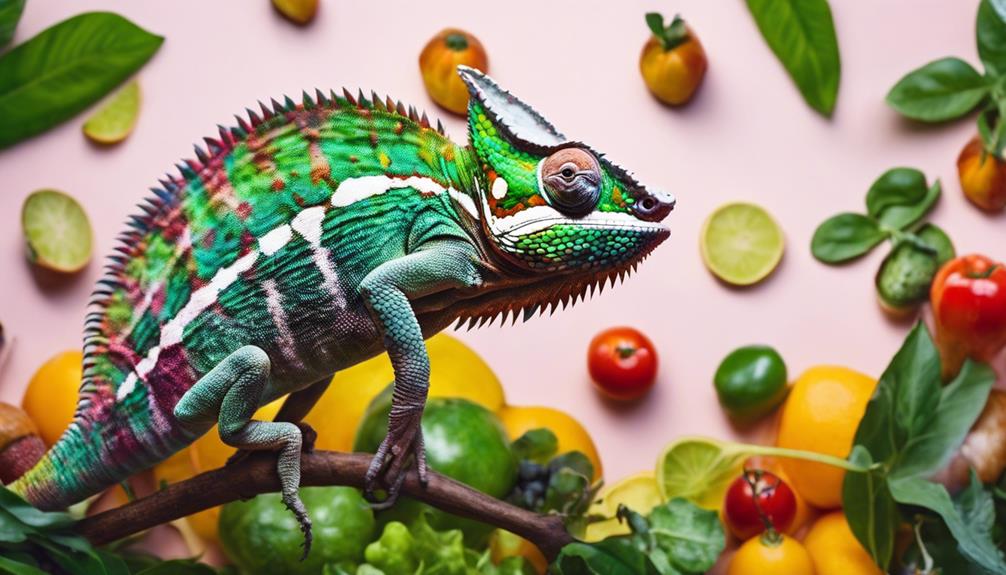When it comes to creating a safe haven for your chameleon, steering the plant world can be like walking through a minefield. Arrowhead plants might seem innocent, but are they truly a friend or foe to your scaly companion? Understanding the potential risks and toxicity concerns associated with Arrowhead plants is essential for the well-being of your chameleon.
But what makes these seemingly harmless plants a cause for concern in your chameleon's habitat? Let's explore this further.
Potential Risks of Arrowhead Plants
When considering arrowhead plants for your chameleon enclosure, it's important to be aware of the potential risks they pose due to their toxic nature. Arrowhead plants, scientifically known as Syngonium podophyllum, contain insoluble calcium oxalates that can be harmful if ingested by chameleons. These toxins are present in all parts of the plant, including the leaves and stems, making them unsafe for your pet. Ingesting Arrowhead plants can lead to symptoms such as drooling, difficulty swallowing, and digestive issues in chameleons.
To guarantee the safety and well-being of your chameleon, it's highly recommended to avoid using Arrowhead plants in their enclosure. Opting for non-toxic plants will help mitigate the risks of accidental ingestion and potential health complications. By selecting safe plants for your chameleon's habitat, you can create a secure environment that promotes their overall health and happiness. Remember, prevention is key when it comes to safeguarding your chameleon from toxic substances.
Toxicity Concerns for Chameleons
Considering the potential risks associated with the toxicity of Arrowhead plants, it's imperative to understand the concerns regarding toxicity for chameleons.
- Arrowhead plants, including all parts of the plant, are considered poisonous and unsafe for chameleons.
- Research indicates that ingestion of Arrowhead plants can pose risks and potential toxicity for chameleons.
- Chameleons may not exhibit immediate symptoms after consuming toxic Arrowhead plants, emphasizing the need for caution.
- Differentiating between safe and toxic plants is essential to prevent harm and guarantee chameleon health.
- Monitoring chameleon behavior around Arrowhead plants is essential to assess and prevent potential ingestion risks.
It is vital to acknowledge the dangers posed by Arrowhead plants to chameleons due to their poisonous nature. Regularly observing your chameleon's interactions with plants and promptly removing any unsafe options can protect your pet from accidental ingestion. Stay vigilant and prioritize the well-being of your chameleon by creating a safe environment free from toxic plants.
Safe Alternatives to Arrowhead Plants
For chameleon owners seeking secure alternatives to Arrowhead plants, consider incorporating Golden Pothos, Ficus Plants, and Schefflera Trees in your pet's habitat. These plants are non-toxic to chameleons and can provide a lush and green environment in their cage.
Golden Pothos, also known as Epipremnum aureum, is a popular choice due to its low-maintenance nature and air-purifying properties. Ficus Plants, such as Ficus benjamina, commonly known as the Weeping Fig, are another excellent choice as they're safe for chameleons and add a touch of elegance to the indoor plant collection.
Schefflera Trees, with their umbrella-like foliage, aren't only safe but also resilient and can thrive in various conditions within the chameleon habitat. By selecting plants from safe plant lists like Hibiscus, Grape Ivy, and Areca Palm, you can guarantee a healthy and secure environment for your chameleon.
Prioritizing chameleon safety by avoiding toxic plants like Arrowhead and opting for secure alternatives is essential for their well-being and longevity.
Best Practices for Plant Selection
To guarantee the safety and well-being of your chameleon, meticulous plant selection is paramount. When choosing plants for your chameleon's habitat, consider the following best practices:
- Research Plant Toxicity: Before introducing any plant into your chameleon's environment, thoroughly research its toxicity levels, especially plants like Arrowhead plants which are known to be hazardous.
- Prioritize Chameleon Safety: Always prioritize the safety of your chameleon by selecting non-toxic plants that pose minimal risks of ingestion.
- Seek Expert Advice: Consult with reptile experts or veterinarians to gain valuable insights into safe plant options for your chameleon's habitat.
- Carefully Evaluate Plant Selection: Take the time to carefully evaluate each plant before adding it to your chameleon's enclosure to ensure it meets safety standards.
- Understand Risks of Ingestion: Educate yourself about the potential risks associated with plant ingestion, as chameleons may accidentally consume harmful plants if not chosen wisely.
Following these best practices will help create a safe and healthy environment for your chameleon, minimizing the risks of plant toxicity.
Creating a Chameleon-Friendly Environment
Creating a chameleon-friendly habitat requires careful consideration of plant selection and environmental factors to guarantee the well-being of your pet. When setting up your chameleon's cage, opt for non-toxic plants such as hibiscus, ficus, or pothos to create a safe environment. Avoid toxic plants like Arrowhead plants, as they can be harmful if ingested.
Regularly monitor your chameleon's behavior around plants to make sure they aren't nibbling on anything hazardous. Chameleons may not show immediate symptoms after consuming toxic plants, making it important to be proactive in preventing any potential risks.
Frequently Asked Questions
Are Arrowhead Plants Toxic to Reptiles?
Arrowhead plants are toxic to reptiles due to insoluble calcium oxalate crystals. Avoid them in chameleon diet for reptile safety. Opt for safe plant alternatives to guarantee chameleon health and well-being.
Are Arrowhead Plants Toxic to Pets?
Pet safety is important. Plants like Arrowhead are toxic to pets, causing harm like oral irritation and vomiting. Guarantee chameleon diet safety by avoiding toxic plants. Monitor indoor plants for reptile care, prioritizing their well-being.
Are Arrowhead Plants Good for Terrariums?
In terrarium design, guarantee plant care by selecting non-toxic options like ferns or spider plants. Provide appropriate lighting needs, utilize well-draining soil types, and adjust watering frequency based on plant requirements for a thriving environment.
What Plants Are Safe for Chameleons to Eat?
When it comes to chameleons, ensuring they have access to safe plants is essential for their health. Providing edible vegetation like Golden Pothos and Ficus Plants, along with safe foliage, is key for their well-being.
Conclusion
To summarize, it's best to steer clear of arrowhead plants for your chameleon's safety. While they may look appealing, these plants can pose serious risks if ingested.
Opt for safer alternatives and always prioritize your chameleon's well-being. Remember, a little extra caution goes a long way in creating a healthy and happy environment for your scaly friend.


